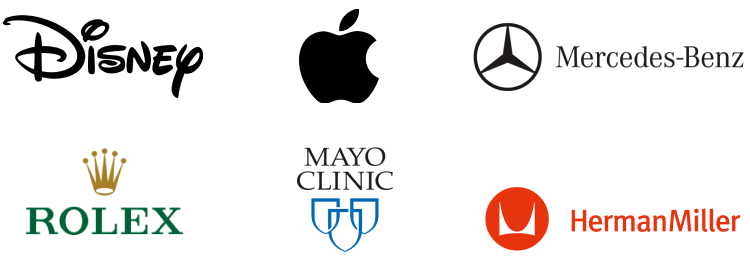Education on Quality

As a Digital Product Company - we ask ourselves… “What does Product Quality really mean?”
And to have a balanced answer, we can use some of the research and publications from MIT that shared 5 different approaches to defining quality.
- Transcendent Approach
- Product-based Approach
- User-based Approach
- Manufacturing-based Approach
- Value-based Approach
Transcendent Approach
The concept here is synonymous with “innate excellence”. It is universally recognizable when a mark of uncompromising standards and high achievement are met. However, at times this type of quality is challenging to define precisely, and we tend to learn to recognize it only through direct experience.
Examples of Brands that are Known for Excellence

Product-Based Approach
As compared to the Transcendent Approach, here quality is viewed as precise and a measurable variable. Goods can be ranked according to the number of desired attributes that they possess. And in most cases, you are looking for product attributes that are considered preferable by buyers. However, this can be complicated with blends of different attributes.
Examples of Products with Desired Attributes
CPUs
Measurement in GHz (more speed)
Ice Cream
High Butterfat Content (rich creamy flavor)
Engines
Horsepower Characteristics (power and speed)
Screens
Pixels Per Inch (screen resolution quality)
Cameras
Mega Pixels (photo resolution size)
The User-Based Approach
The essence for this approach is basic in nature in that the quality “lies in the eyes of the beholder”. Users of products have needs and wants and how these are satisfying their preferences can affect implications for perceptions of quality. A major challenge with this approach is the variance of preferences for users that need to be suitable for the masses, not just a few. An important concept to think about… A product that maximizes satisfaction is certainly preferable to one that meets fewer needs, but is it necessarily better as well?
Examples Through the Lens of Thermostats for Your Home
You can have a standard thermostat that you have to set manually to control your HVAC systems.
VS
The Nest by Google that uses artificial intelligence and machine learning to learn the habits of your home by tracking when you are away and suggesting a perfect blend between savings and comfort.
Both can provide a good experience to the user, but different users have different needs when experiencing a product.
The Manufacturing-Based Approach
This approach deals more with manufacturing specs and definitions which focus on the supply side of the equation as well as engineering. Here there is a reconciliation of excellence between product meeting specifications and producing the product right the first time. The evolution of manufacturing products now includes concepts such as efficiency ratings, eco-friendly considerations, and how parts can be broken down and re-used for better sustainability with elimination of waste.
Examples from a Manufacturing Perspective
Adopting energy-efficient practices to cut costs
Finding alterative process or use cases for raw material waste
Selecting environmentally-friendly materials to design products
Reducing use of harmful chemicals or bi-products during manufacturing
The Value-Based Approach
Here we actually define quality as a bi product of costs and prices. According to this perspective, delivering performance is a given, but it needs to be accomplished through an acceptable tolerance of cost to the consumer. Imagine a product that is way too expensive for 99% of people to afford. With this approach, quality doesn’t matter as it has an extremely limited market. Quality as it has a relationship associated to price is something all product designers should intelligently discuss.
Through retrospection of these five different approaches, production teams must understand the differences and be flexible in terms of what definitions of quality they are using or are after. Understanding that there may be some conflicts depending on what approach blend is used and how you choose to measure quality matters greatly.
EXAMPLES THROUGH THE LENS OF A SPORTSCAR
Honda Accord vs Chevy Corvette vs Ferrari Spider; they all get you from point A to point B. But how they were manufactured and how you judge quality per price can be debated. And of course, I think we all need Ferrari’s in our lives

Besides thinking of the approaches mentioned above, we can also dive into deeper more detailed categories of topics such as the “8 Dimensions of Quality”:
Performance
Operating characteristics of a product
Features
All the bells and whistles of a product
Reliability
The probability of a product failing
Conformance
How well product design matches product standards
Durability
What is the product life cycle
Serviceability
How fast a product can be adjusted or fixed
Aesthetics
How a product looks, feels, sounds, tastes or smells
Perceived Quality
Perception of product compared to competitor/ similar products
While all of these 8 dimensions work in parallel, the overall scores from these can vary as some of them might be high whereas others can score low. But they all have importance as to how we can leverage these categories as we plan to build our products.
In Summary
As a digital product development company that focuses on custom software, process workflows, integrations through designing apps; we are extremely strong when it comes to planning. We leverage proven methodologies across design, technology and business and discussions around “quality” is paramount. Key decisions based on planning and controlling quality can make or break your business model.
We strongly recommend that you consider these kinds of topics when creating your product roadmap. If you are thinking of or in process of discovery, and need any consulting assistance, please reach out to our team. We’re always looking for opportunities to “work on cool projects with cool people.”
Schedule Your Free Strategic Project Review & Project Brief
Developing great digital products is our passion. Not sure how to start that journey? Let us help you find the right path. Schedule a free 1-hour consultation with our team. At the end we’ll deliver a Project Brief that will help you to crystalize your vision.









